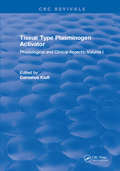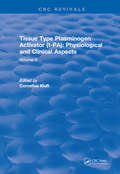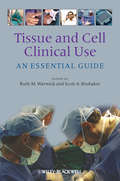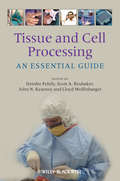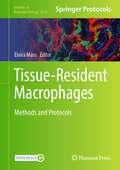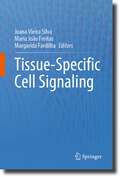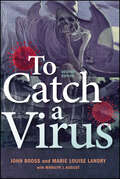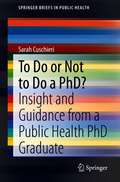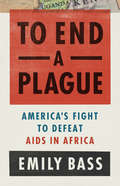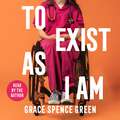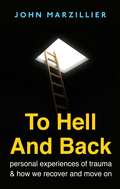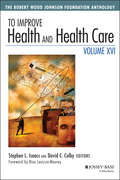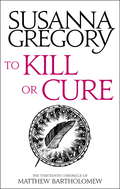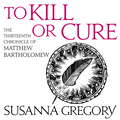- Table View
- List View
Tissue Functioning and Remodeling in the Circulatory and Ventilatory Systems
by Marc ThirietThe volumes in this authoritative series present a multidisciplinary approach to modeling and simulation of flows in the cardiovascular and ventilatory systems, especially multiscale modeling and coupled simulations. Volume 5 is devoted to cells, tissues, and organs of the cardiovascular and ventilatory systems with an emphasis on mechanotransduction-based regulation of flow. The blood vessel wall is a living tissue that quickly reacts to loads applied on it by the flowing blood. In any segment of a blood vessel, the endothelial and smooth muscle cells can sense unusual time variations in small-magnitude wall shear stress and large-amplitude wall stretch generated by abnormal hemodynamic stresses. These cells respond with a short-time scale (from seconds to hours) to adapt the vessel caliber. Since such adaptive cell activities can be described using mathematical models, a key objective of this volume is to identify the mesoscopic agents and nanoscopic mediators required to derive adequate mathematical models. The resulting biomathematical models and corresponding simulation software can be incorporated into platforms developed in virtual physiology for improved understanding and training.
Tissue Morphogenesis
by Celeste M. NelsonTissue Morphogenesis: Methods and Protocols highlights major techniques, both experimental and computational, for the study of tissue morphogenesis, divided into several sections, with specific focus on techniques to image, manipulate, model and analyze tissue morphogenesis. Chapters focus on imagining analysis of tissue morphogenesis, culture models of tissue morphogenesis, manipulating cells and tissues in vivo, novel model systems to investigate issue morphogenesis and computational models. Written in the highly successful Methods in Molecular Biology series format, chapters include introductions to their respective topics, lists of the necessary materials and reagents, step-by-step, readily reproducible laboratory protocols and tips on troubleshooting and avoiding known pitfalls. Authoritative and practical, Tissue Morphogenesis: Methods and Protocols serves as a primary resource for both fundamental and practical understanding of the techniques used to uncover the basis of tissue morphogenesis.
Tissue Scaffolds (Springer Protocols Handbooks)
by Vineet Kumar Naveen Kumar Sameer Shrivastava Anil Kumar Gangwar Sonal SaxenaThis volume provides a comprehensive introduction into methods and procedures on the preparation and characterization of animal tissue-derived extracellular matrix scaffolds primarily from bubaline, caprine, porcine, ovine, rabbit, rat and fish source. Chapters guide readers through decellularization protocol unique to the particular animal tissue and animal studies outcomes. Authoritative and cutting-edge, Tissue Scaffolds aims to be a useful and practical guide to new researchers and experts looking to expand their knowledge.
Tissue Stem Cells
by Robert B. Clarke James Wilson Christopher S. Potten Andrew G. RenehanTissue stem cells and their medical applications have become a major focus of research over the past decade. With 16 full-color illustrations, this reference provides a thorough and up-to-date overview of the current and emerging technologies for stem cell research and transplantation. Divided into three sections covering general issues, adult stem
Tissue Type Plasminogen Activity: Volume I
by Cornelius KluftThis book is made possible by the enthusiastic contributions of the authors of the chapters. They have been invited from young and active scientists in the field of t-PA research. I am grateful for their contribution and for the fact that all accepted the specifications of their chapter in order to obtain a structured book. Inevitably, some overlap does exist; on the one hand to enable controversial or unsettled areas to be discussed by the different experts with a different approach and background.It is a particular pleasure and honor that Dr. T. Astrup, as an eye-witness and essential contributor to the history of t-PA discovery and research, gives a unique account of the history of t-PA research in the first chapter of the book.
Tissue Type Plasminogen Activity: Volume II
by Cornelius KluftThis book is made possible by the enthusiastic contributions of the authors of the chapters. They have been invited from young and active scientists in the field of t-PA research. I am grateful for their contribution and for the fact that all accepted the specifications of their chapter in order to obtain a structured book. Inevitably, some overlap does exist; on the one hand to enable controversial or unsettled areas to be discussed by the different experts with a different approach and background.It is a particular pleasure and honor that Dr. T. Astrup, as an eye-witness and essential contributor to the history of t-PA discovery and research, gives a unique account of the history of t-PA research in the first chapter of the book.
Tissue and Cell Clinical Use
by Scott A. Brubaker Ruth M. WarwickThis new book explores clinical information in the tissue transplantation field and acts as a comprehensive learning tool to comply with regulatory requirements. Broad in scope, coverage includes all the traditionally transplanted tissues and moves into more complex areas of tissue grafting and the assisted reproduction fields. This useful text focuses on the potential for disease transmission, ways to improve safety, and the role of the clinician in these safety aspects. The book starts off by describing non-surgical risks of using allografts and moves onto chapters devoted completely to tissue- or cell-specific issues relating to transplantation of the individual types of tissues or cells.Tissue and Cell Clinical Use: An Essential Guide is the final book in a series which covers all aspects of tissue banking, donation, processing, and transplantation. Each book in the series includes lists of learning points and case studies which consist of sample processing protocols, descriptions of where processing went wrong, sample risk assessments, or validation studies. This three book series covers all you need to know about tissue banking.
Tissue and Cell Processing
by Scott A. Brubaker Lloyd Wolfinbarger Jr. Deirdre Fehily John N. KearneyBy presenting the latest technological advances and growing national and international regulation, this new book explores state-of-the-art developments in the challenging field of tissue and cell processing. It provides a guide to easier and safer practice in operational principles of preservation, decontamination, and sterilization. Nearly half of the book is devoted completely to tissue- or cell-specific issues relating to processing. With lists of learning points and case studies which consist of sample processing protocols, descriptions of where processing went wrong, sample risk assessments, or validation studies, the authors help you find specific information fast.
Tissue-Protective Cytokines
by Pietro Ghezzi Anthony CeramiWhile many cytokines are known for their inflammatory action, there is a growing interest in the tissue-protective effects of some cytokines. The prototypic tissue-protective cytokine is EPO. Initially described as neuro-protective, it is beneficial in animal models of ischemic and other types of injury. Scientists had to overcome the notion that EPO had only erythropoietic actions, was only produced by the kidney, and that its receptor was only present in erythroid progenitor cells. The use of in vitro and in vivo disease models was essential to demonstrate the protective effects of EPO. Reproducible models will be needed for the further study of the mechanism of action of EPO and for the identification of other tissue-protective cytokines. In Tissue-Protective Cytokines: Methods and Protocols, expert researchers in the field detail the key models that have been used to characterize the tissue-protective actions of cytokines. Written in the highly successful Methods in Molecular BiologyTM series format, chapters include introductions to their respective topics, lists of the necessary materials and reagents, provide step-by-step laboratory protocols, and key tips on troubleshooting and avoiding known pitfalls. Thorough and intuitive, Tissue Protective Cytokines: Methods and Protocols aids scientists in continuing to study tissue-protection that will be a new field of interest of cytokine biology, both in discovering novel actions of known cytokines and in developing new drugs.
Tissue-Resident Macrophages: Methods and Protocols (Methods in Molecular Biology #2713)
by Elvira MassThis detailed book delves into the diverse techniques and applications to target, isolate, image, phenotype, and analyze tissue-resident and monocyte-derived macrophages. The contents aim to describe the current knowledge about macrophage development and function which forces the scientific field to move beyond the previously described M1/M2 macrophage paradigm to be able to dissect macrophage functions within their specific niches during health and disease. Written for the highly successful Methods in Molecular Biology series, chapters include introductions to their respective topics, lists of the necessary materials and reagents, step-by-step and readily reproducible laboratory protocols, and tips on troubleshooting and avoiding known pitfalls. Thorough and practical, Tissue-Resident Macrophages: Methods and Protocols provides scientists entering the macrophage field with information and tools that allow them to dive into the state-of-the-art methodology used in this vital field.
Tissue-Specific Cell Signaling
by Joana Vieira Silva Maria João Freitas Margarida FardilhaSignal transduction comprises the intracellular biochemical signals which induce the appropriate cell response to an external stimulus. The players in signal transduction are diverse, from small molecules as first messengers, to proteins, receptors, transcription factors, among many others. The different signaling pathways and the crosstalk between them originates the unique signaling profile of every cell type in the human body. The cell signaling specificity depends on several aspects including protein composition, subcellular localization and complexes and gene promoters.This textbook provides a comprehensive overview of the specific signaling pathways on a variety of human tissues. This information can be of great value for health science researchers, professionals and students to understand key pathways for tissue-specific functions in the plethora of signals, signals receptors, transducers and effectors.Chapter 3 and 15 are available open access under a Creative Commons Attribution 4.0 International License via link.springer.com.
Tissue-Specific Estrogen Action
by Tim Wintermantel Kenneth S. KorachCurrent molecular understanding of estrogen action has greatly profited from advances in molecular cell biology. These advances, and their implications for clinical use, were discussed by leading researchers from industry and academia during an international symposium held in Berlin, 1-3 March 2006 and are featured in this volume.
Tissue-Specific Stem Cell Niche
by Kursad TurksenThis timely volume explores tissue-derived stem cells, summarizing and evaluating the current body of knowledge. Sixteen chapters cover hematopoietic, osteoblast, skeletal, cardiac, pancreatic, epithelial, corneal, hepatic, renal, testicular, ovarian, fingernail, hair follicle and other stem cells- discussing their individual development, functions and pathologies, as well as the commonalities and interdependence between niches. This installment of the popular Stem Cell Biology and Regenerative Medicine series delivers authoritative, international perspectives on this rapidly growing field. Tissue-Specific Stem Cell Niche is an ideal complementary volume to Biology of Stem Cell Niche and Adult Stem Cells, Second Edition and will be invaluable to clinicians and researchers working with stem cells as well as to postgraduate trainees who are studying them.
Titanium: Metallic Pollutants in the Aquatic Environment
by Rachel Ann Hauser-DavisThis book engages readers in an integrated and holistic discussion on titanium properties, applications, bioanalytical approaches and toxicity. Key issues include environmental titanium exposure and associated health risk concerns for both humans and aquatic organisms, exploring ecotoxicological effects. The book delves into the intricate web of ecotoxicological effects, offering valuable insights for researchers and professionals alike. With a broad appeal, this book is an indispensable resource for those immersed in the realms of oceanography, geochemistry, ecotoxicology, and environmental and public health, providing a multidisciplinary perspective on the intricate interplay between titanium and the natural world.
To Catch A Virus (ASM Books)
by Marie Louise Landry John BoossTo Catch a VirusTrace the evolution of diagnostic virology from yellow fever to COVID-19 Join expert storytellers John Booss, Marilyn J. August, and Marie Louise Landry in a journey through the history of viral epidemics and the detective work of those determined to identify the culprits and treat the infected. From the identification of the first virus in the late 1800s to the molecular techniques that enabled the rapid recognition of and vaccine development for the SARS-CoV-2 virus, viral diagnostic methods have progressed over the past century to become a formidable tool in human health care. This collection of gripping historical narratives covers a range of fascinating outbreaks and public health challenges, from yellow fever and smallpox to AIDS and COVID-19. This new edition chronicles the ongoing story of the COVID-19 pandemic, highlighting the people, the pathogen, and the progress in the diagnostic laboratory and clinical settings that has touched every aspect of global health. The many photographs and rich biographical sketches of key figures, diagrams of diagnostic procedures, micrographs of virus-infected cells, timelines, and a new glossary of key terms make To Catch a Virus compelling reading. This book serves as an excellent resource for courses in virology, immunology, microbiology, and public health. As the world struggles with the ongoing pandemic of SARS-CoV-2/COVID-19, To Catch a Virus is an insightful and superbly told story that chronicles the incredible metamorphosis of diagnostic virology and the technological advances that now make it possible to quickly and accurately detect and monitor the many disease-causing viruses that plague humankind. A stimulating, informative, and absorbing read that is highly recommended.—Richard L. Hodinka, PhD, Professor Emeritus, Perelman School of Medicine at the University of Pennsylvania; former Director, Clinical Virology Laboratory, Children&’s Hospital of Philadelphia To Catch a Virus provides a beautifully written and compelling story of scientific discovery. It carefully traces the understanding of viral diseases from the turn of the twentieth century to the present. For general readers the authors provide timely and expert guidance to the extraordinary advances in diagnosis, surveillance, and therapeutics that constitute the silver lining in the otherwise somber years of COVID-19. For anyone wishing to understand the challenges confronting virologists and their accomplishments to date, this work is the place to start.—Frank M. Snowden, PhD, Andrew Downey Orrick Professor Emeritus of History, Yale University; former Chair, Program in History of Science and History of Medicine, Yale University
To Do or Not to Do a PhD?: Insight and Guidance from a Public Health PhD Graduate (SpringerBriefs in Public Health)
by Sarah CuschieriThis book prepares and guides individuals who are about to embark (or already have embarked) on a health/medical PhD journey, with a specific focus on Public Health. Based on the author's experience as a recently graduated Doctor of Philosophy (PhD) student, readers benefit from the knowledge imparted and lessons learned, including an analysis of the different aspects of a Public Health doctoral degree, and practical tips and guidance on how to go about this journey from the initial phase of choosing a research niche up until the oral examination (also called defence). All throughout the book, the author shares examples from her own journey to show that in spite of sacrifices and hurdles along the way, hard work, perseverance, and supportive resources can help see you through, eventually, to a hopefully positive outcome at the end.Using an informal style, the author provides a step-wise guide, from chapter to chapter, on the various essential aspects that need to be considered, including:The initial steps towards a PhDProposal, permissions and fundingThe fieldworkThe art of data analysisThe hurdles along the way – a personal experienceWhat comes after the completion of a PhD?Intended to be a compact go-to guide for students throughout their PhD journey, both from an academic and personal perspective, To Do or Not to Do a PhD? engages readers who are about to enroll in or who already have started a PhD, especially in public health, epidemiology, and health/medical fields of study. The brief also would appeal to postgraduate and undergraduate students who are interested in learning about how to write a research proposal, draft a scientific paper for publication in a journal, or prepare a thesis.
To End a Plague: America's Fight to Defeat AIDS in Africa
by Emily Bass&“Randy Shilts and Laurie Garrett told the story of the HIV/AIDS epidemic through the late 1980s and the early 1990s, respectively. Now journalist-historian-activist Emily Bass tells the story of US engagement in HIV/AIDS control in sub-Saharan Africa. There is far to go on the path, but Bass tells us how far we&’ve come.&” —Sten H. Vermund, professor and dean, Yale School of Public Health With his 2003 announcement of a program known as PEPFAR, George W. Bush launched an astonishingly successful American war against a global pandemic. PEPFAR played a key role in slashing HIV cases and AIDS deaths in sub-Saharan Africa, leading to the brink of epidemic control. Resilient in the face of flatlined funding and political headwinds, PEPFAR is America&’s singular example of how to fight long-term plague—and win. To End a Plague is not merely the definitive history of this extraordinary program; it traces the lives of the activists who first impelled President Bush to take action, and later sought to prevent AIDS deaths at the whims of American politics. Moving from raucous street protests to the marbled halls of Washington and the clinics and homes where Ugandan people living with HIV fight to survive, it reveals an America that was once capable of real and meaningful change—and illuminates imperatives for future pandemic wars. Exhaustively researched and vividly written, this is the true story of an American moonshot.
To Err is Human: Building a Safer Health System
by Linda T. Kohn Janet M. Corrigan Molla S. DonaldsonExperts estimate that as many as 98,000 people die in any given year from medical errors that occur in hospitals. That's more than die from motor vehicle accidents, breast cancer, or AIDS--three causes that receive far more public attention. Indeed, more people die annually from medication errors than from workplace injuries. Add the financial cost to the human tragedy, and medical error easily rises to the top ranks of urgent, widespread public problems. To Err Is Human breaks the silence that has surrounded medical errors and their consequence--but not by pointing fingers at caring health care professionals who make honest mistakes. After all, to err is human. Instead, this book sets forth a national agenda--with state and local implications--for reducing medical errors and improving patient safety through the design of a safer health system. This volume reveals the often startling statistics of medical error and the disparity between the incidence of error and public perception of it, given many patients' expectations that the medical profession always performs perfectly. A careful examination is made of how the surrounding forces of legislation, regulation, and market activity influence the quality of care provided by health care organizations and then looks at their handling of medical mistakes. Using a detailed case study, the book reviews the current understanding of why these mistakes happen. A key theme is that legitimate liability concerns discourage reporting of errors--which begs the question, "How can we learn from our mistakes?" Balancing regulatory versus market-based initiatives and public versus private efforts, the Institute of Medicine presents wide-ranging recommendations for improving patient safety, in the areas of leadership, improved data collection and analysis, and development of effective systems at the level of direct patient care. To Err Is Human asserts that the problem is not bad people in health care--it is that good people are working in bad systems that need to be made safer. Comprehensive and straightforward, this book offers a clear prescription for raising the level of patient safety in American health care. It also explains how patients themselves can influence the quality of care that they receive once they check into the hospital. This book will be vitally important to federal, state, and local health policy makers and regulators, health professional licensing officials, hospital administrators, medical educators and students, health caregivers, health journalists, patient advocates--as well as patients themselves. First in a series of publications from the Quality of Health Care in America, a project initiated by the Institute of Medicine.
To Exist As I Am: A Doctor's Notes on Recovery and Radical Acceptance
by Grace Spence GreenREAD BY THE AUTHOR.'Astonishing, important, and truly radical ... this book is completely transformative' POLLY MORLAND 'To Exist As I Am reflects on the boundaries between those who care, and those who receive care in an absolutely extraordinary way ... Essential reading' XAND VAN TULLEKEN 'Inspiring and life-affirming' VIV GROSKOP It wasn't a car crash, but there was a collision. He fell from the third floor. At the age of twenty-two, Grace Spence Green's spine was broken at the fourth thoracic vertebra, and her life changed tracks. One day, she was in hospital supporting patients, the next she was one. To Exist As I Am traces Grace's journey back to the wards and back to herself - as words like recovery, independence and community, well and unwell, took on new meanings. She asks how we might fight for change, while joyously embracing life exactly as we are. 'It'll change the way you think about disability. Stop whatever it is that you're reading and read Grace Spence Green instead' GAVIN FRANCIS 'Unputdownable, awe-inspiring, necessary' GABRIEL WESTON 'So true and so beautiful' TOM SHAKESPEARE'
To Fix or To Heal: Patient Care, Public Health, and the Limits of Biomedicine (Biopolitics #3)
by Joseph E. Davis Ana Marta GonzálezDo doctors fix patients? Or do they heal them? For all of modern medicine’s many successes, discontent with the quality of patient care has combined with a host of new developments, from aging populations to the resurgence of infectious diseases, which challenge medicine’s overreliance on narrowly mechanistic and technical methods of explanation and intervention, or “fixing’ patients. The need for a better balance, for more humane “healing” rationales and practices that attend to the social and environmental aspects of health and illness and the experiencing person, is more urgent than ever. Yet, in public health and bioethics, the fields best positioned to offer countervailing values and orientations, the dominant approaches largely extend and reinforce the reductionism and individualism of biomedicine.The collected essays in To Fix or To Heal do more than document the persistence of reductionist approaches and the attendant extension of medicalization to more and more aspects of our lives. The contributors also shed valuable light on why reductionism has persisted and why more holistic models, incorporating social and environmental factors, have gained so little traction. The contributors examine the moral appeal of reductionism, the larger rationalist dream of technological mastery, the growing valuation of health, and the enshrining of individual responsibility as the seemingly non-coercive means of intervention and control. This paradigm-challenging volume advances new lines of criticism of our dominant medical regime, even while proposing ways of bringing medical practice, bioethics, and public health more closely into line with their original goals. Precisely because of the centrality of the biomedical approach to our society, the contributors argue, challenging the reductionist model and its ever-widening effects is perhaps the best way to press for a much-needed renewal of our ethical and political discourse.
To Heal Humankind: The Right to Health in History
by Adam GaffneyThe "human right to healthcare" has had a remarkable rise. It is found in numerous international treaties and national constitutions, it is litigated in courtrooms across the globe, it is increasingly the subject of study by scholars across a range of disciplines, and—perhaps most importantly—it serves as an inspiring rallying cry for health justice activists throughout the world. However, though increasingly accepted as a principle, the historical roots of this right remain largely unexplored. To Heal Humankind: The Right to Health in History fills that gap, combining a sweeping historical scope and interdisciplinary synthesis. Beginning with the Age of Antiquity and extending to the Age of Trump, it analyzes how healthcare has been conceived and provided as both a right and a commodity over time and space, examining the key historical and political junctures when the right to healthcare was widened or diminished in nations around the globe. To Heal Humankind will prove indispensable for all those interested in human rights, the history of public health, and the future of healthcare.
To Hell and Back: Personal Experiences of Trauma and How We Recover and Move on
by John MarzillierDespite how rare one-off traumatic events may seem, the statistics show that the majority of us are likely to experience such trauma at some point in our lives. In this innovative and engaging book, Marzillier combines first-hand accounts from trauma sufferers with over forty years of clinical practice to provide an honest, human description of how trauma affects us at the time and also after the event. Whether discussing accounts of terrorist bombings, natural disasters, road accidents or physical attacks, he looks at what these experiences do to us and offers practical and consoling advice - for both sufferers and their loved ones - on coping with the experience and developing resilience for the future.
To Improve Health and Health Care, Volume XVI
by Stephen L. Isaacs David C. Colby Risa Lavizzo-MoureyThe RWJF's biannual update on the latest developments in U.S. health care To Improve Health and Health Care is the Robert Wood Johnson Foundation's biannual anthology, focusing on the pressing health and health care issues facing the country. <P><P>This volume covers some of the most important topics in public health, preventative medicine, and health services. Readers will find an in-depth look into the programs funded by the Robert Wood Johnson Foundation, providing policy makers, practitioners, and interested members of the public a valuable perspective to inform strategy for the coming years. As part of the Foundation's efforts to inform the public, this ongoing anthology of the RWJF provides an update on the latest developments and advances taking place in the field of health, bringing readers up to speed on where we are, and where we still need to go. Understand the new developments in reducing childhood obesity Examine innovations in health care delivery Learn how RWJF programs are making a difference to patients and providers Since 1972, the Robert Wood Johnson Foundation has been the nation's largest philanthropy devoted exclusively to health. To further its mission of improving the health and health care of all Americans, the Foundation strives to foster innovation, develop ideas, disseminate information, and enable committed people to devote their energies to improving the nation's well-being. To Improve Health and Health Care describes the latest outcomes and progress, for a complete overview of the American health care system.
To Kill Or Cure: The Thirteenth Chronicle of Matthew Bartholomew (Chronicles of Matthew Bartholomew #13)
by Susanna GregoryFor the twentieth anniversary of the start of the Matthew Bartholomew series, Sphere is delighted to reissue all of the medieval monk's cases with beautiful new series-style covers.------------------------------------The winter of 1353 has been appallingly wet, there is a fever outbreak amongst the poorer townspeople and the country is not yet fully recovered from the aftermath of the plague. The increasing reputation and wealth of the Cambridge colleges are causing dangerous tensions between the town, Church and University. Matthew Bartholomew is called to look into the deaths of three members of the University of who died from drinking poisoned wine, and soon he stumbles upon criminal activities that implicate his relatives, friends and colleagues - so he must solve the case before matters in the town get out of hand...In the year 1357, Cambridge University is in dire financial straits: the town's landlords are demanding an extortionate rent rise for the students' hostels and the plague years have left the colleges with scant resources. Tension between town and gown is at boiling point and soon explodes into violence and death. Into this maelstrom comes a charismatic physician whose healing methods owe more to magic than medicine - but his success threatens Matthew Bartholomew's professional reputation, and his life ...
To Kill Or Cure: The Thirteenth Chronicle of Matthew Bartholomew (Chronicles of Matthew Bartholomew #13)
by Susanna GregoryCambridge University is in dire financial straits: the town's landlords are demanding an extortionate rent rise for the students' hostels and the plague years have left the colleges with scant resources. Tension between town and gown is at boiling point and soon explodes into violence and death. Into this maelstrom comes a charismatic physician whose healing methods owe more to magic than medicine but his success threatens Matthew Bartholomew's professional reputation, and his life ...




